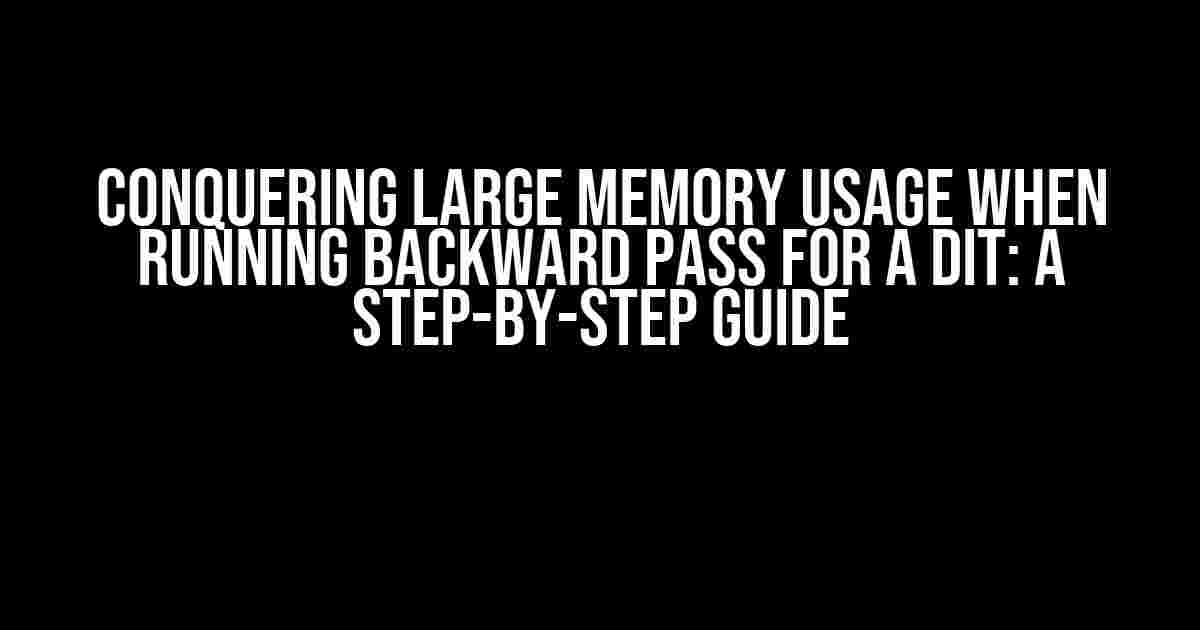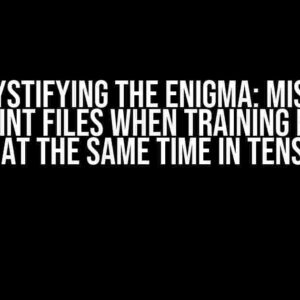Are you tired of dealing with memory issues when training your Deep Interaction Transformer (DiT) model? Do you find yourself stuck in the mud, unable to move forward due to the enormous memory usage during the backward pass? Fear not, dear reader, for we have got you covered!
What Causes Large Memory Usage?
Before we dive into the solutions, let’s first understand what causes this issue. The main culprit behind large memory usage during the backward pass is the accumulation of intermediate results. You see, when you compute gradients, PyTorch (or any other deep learning framework) needs to store the intermediate results to compute the gradients of the loss with respect to the model’s parameters. This can lead to a massive memory footprint, especially when dealing with large models and batch sizes.
Consequences of Large Memory Usage
-
Slow training times: When your model consumes too much memory, the training process slows down, and you’ll be stuck waiting for hours, if not days.
-
GPU memory constraints: With limited GPU memory, you’ll be forced to reduce batch sizes, which can negatively impact model performance.
-
Increased risk of OOM errors: Out-of-memory errors can be frustrating and even cause you to lose precious training time.
Solutions to Reduce Memory Usage
Now that we’ve identified the problem, let’s explore some practical solutions to reduce memory usage during the backward pass:
1. Gradient Checkpointing
Gradient checkpointing is a technique where you store only the gradients of the model’s parameters at certain intervals, rather than storing the entire computation graph. This can significantly reduce memory usage.
import torch
from torch.utils.checkpoint import checkpoint
# Define your model and optimizer
# During training
for input, target in dataset:
output = model(input)
loss = criterion(output, target)
optimizer.zero_grad()
with torch.no_grad():
loss.backward(retain_graph=True) # retain_graph=True is necessary for gradient checkpointing
optimizer.step()2. Mixed Precision Training
Mixed precision training involves using lower precision data types (e.g., float16) for model parameters and gradients, while maintaining the original precision for the model’s weights. This can lead to significant memory savings.
import torch
from apex import amp
# Define your model and optimizer
# Initialize mixed precision
model, optimizer = amp.initialize(model, optimizer, opt_level='O1')
# During training
for input, target in dataset:
output = model(input)
loss = criterion(output, target)
optimizer.zero_grad()
loss.backward()
optimizer.step()3. Gradient Accumulation
Gradient accumulation involves accumulating gradients over multiple mini-batches before updating the model’s parameters. This can help reduce memory usage by reducing the number of gradient computations.
import torch
# Define your model and optimizer
# Set the accumulation count
accumulation_count = 4
gradient_accumulator = []
# During training
for input, target in dataset:
output = model(input)
loss = criterion(output, target)
optimizer.zero_grad()
loss.backward()
gradient_accumulator.append(loss.grad)
if len(gradient_accumulator) % accumulation_count == 0:
optimizer.step()
gradient_accumulator = []4. Model Pruning
Model pruning involves removing redundant or unnecessary model parameters to reduce memory usage. This can be done using techniques like L1 regularization or magnitude-based pruning.
import torch.nn.utils.prune as prune
# Define your model and optimizer
# Define the pruning mask
mask = prune.ln_structured(amount=0.2, n=2, dim=0, importance_scores=lambda x: x.norm(dim=0))
# Apply the pruning mask
prune.custom_from_mask(model, mask)Additional Tips and Tricks
In addition to the solutions mentioned above, here are some additional tips to help reduce memory usage:
Use Batch Size Reduction
Reduce batch sizes to decrease memory usage. However, be careful not to reduce the batch size too much, as this can impact model performance.
Use Model Parallelism
Use model parallelism to split the model across multiple GPUs, reducing the memory footprint on each GPU.
Avoid Using torch.autograd.grad
Avoid using torch.autograd.grad, as it stores the entire computation graph, leading to increased memory usage.
Conclusion
In this article, we’ve explored the causes of large memory usage during the backward pass for a DiT model and provided practical solutions to reduce memory usage. By implementing these techniques, you’ll be able to train your DiT model more efficiently, reducing the risk of OOM errors and slow training times. Remember, every byte counts when it comes to deep learning!
| Solution | Memory Reduction | Implementation Complexity |
|---|---|---|
| Gradient Checkpointing | Medium-High | Low-Medium |
| Mixed Precision Training | High | Medium |
| Gradient Accumulation | Low-Medium | Low |
| Model Pruning | High | Medium-High |
Note: The memory reduction and implementation complexity columns are subjective and may vary depending on the specific use case.
Frequently Asked Question
Are you having trouble with large memory usage when running the backward pass for a Deep In Time (DiT) model? Don’t worry, we’ve got you covered! Here are some frequently asked questions and answers to help you optimize your DiT model’s memory usage.
Q1: What causes large memory usage during the backward pass in DiT?
The backward pass in DiT requires storing the activations and gradients of all previous time steps, which can lead to large memory usage. This is because the model needs to compute the gradients of the loss function with respect to the model’s parameters, and this process involves storing the intermediate results.
Q2: How can I reduce memory usage during the backward pass in DiT?
One way to reduce memory usage is to use gradient checkpointing, which involves storing only the gradients of the model’s parameters at certain time steps and recomputing the gradients of the intermediate time steps during the backward pass. Another approach is to use mixed precision training, which uses lower precision data types to reduce memory usage.
Q3: What is gradient checkpointing, and how does it help with memory usage?
Gradient checkpointing is a technique that stores the gradients of the model’s parameters at certain time steps, and recomputes the gradients of the intermediate time steps during the backward pass. This approach reduces memory usage by avoiding the need to store the gradients of all previous time steps. As a result, the memory usage is reduced, and the training process becomes more efficient.
Q4: Can I use model parallelism to reduce memory usage during the backward pass in DiT?
Yes, model parallelism can be used to reduce memory usage during the backward pass in DiT. By parallelizing the model across multiple GPUs or machines, the memory usage is distributed across multiple devices, reducing the memory requirements for each device. This approach can significantly reduce memory usage, especially for large DiT models.
Q5: Are there any other techniques to reduce memory usage during the backward pass in DiT?
Yes, there are several other techniques to reduce memory usage during the backward pass in DiT, including using sparse gradients, gradient compression, and gradient sparsification. These techniques can further reduce memory usage, but may require additional computational resources and may affect the model’s accuracy.



